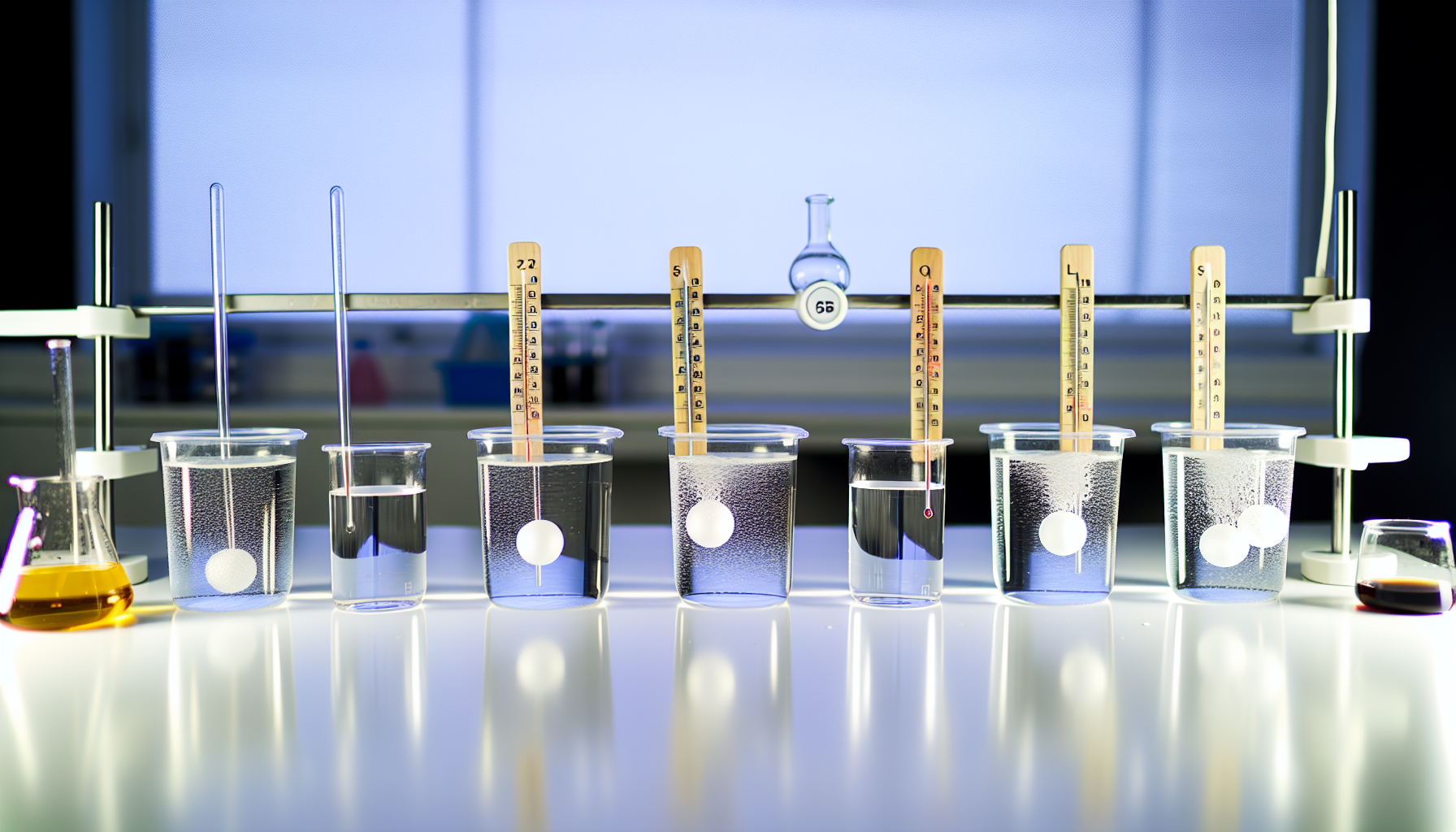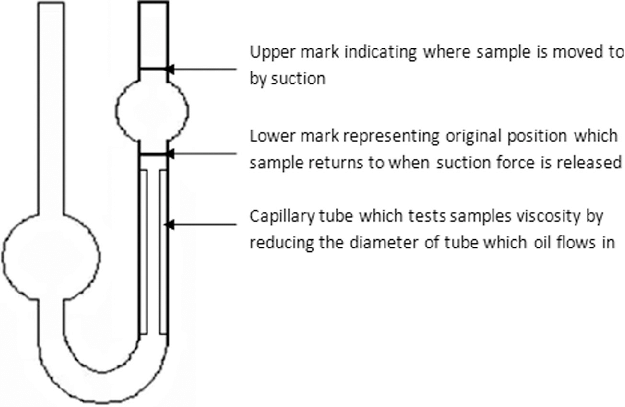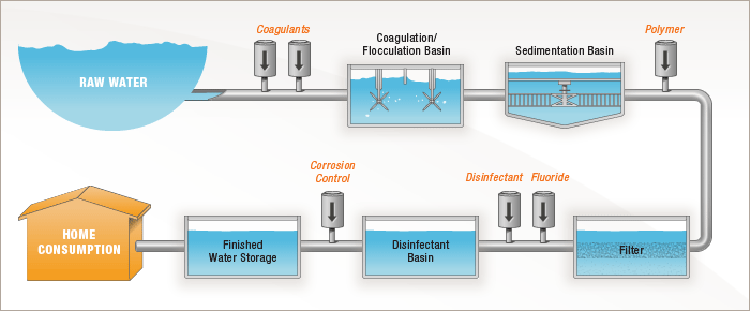Kinematic viscosity of water is a measure of its resistance to flow, essential for predicting how water will behave in real-world scenarios. Whether you’re an engineer, a hydrologist, or a student, grasping this concept is key. In this guide, we’ll look at how temperature and other factors alter water’s viscosity, explore its measurement, and explain its importance in practical applications — without getting caught up in jargon.
Key Takeaways
- Kinematic viscosity is a critical property of fluids such as water, which measures resistance to flow and incorporates fluid density, and is typically expressed in centistokes (cSt).
- The kinematic viscosity of water is primarily affected by temperature (inversely related), with pressure and impurities like salts also influencing it, albeit to a lesser extent.
- Measuring kinematic viscosity involves instruments like capillary, rotational, and falling sphere viscometers, and understanding this property is vital in fields such as water treatment, environmental monitoring, and engineering.
Understanding Kinematic Viscosity

Imagine you’re pouring water and oil into separate containers. You’ll quickly notice that water flows faster than oil. This difference in fluid flow rate is due to a key property of fluids known as kinematic viscosity. Kinematic viscosity, a measure of a fluid’s resistance to flow or internal friction, is a significant factor in predicting fluid behavior in various conditions, ranging from water flow in rivers to blood circulation in our bodies. Fluid density also plays a role in determining the flow characteristics of different substances. In addition to kinematic viscosity, volume viscosity is another important parameter to consider when analyzing fluid flow.
Kinematic viscosity doesn’t operate in isolation; it is intimately connected with dynamic or absolute viscosity, another form of viscosity. Unlike dynamic viscosity, which only considers a fluid’s internal resistance to flow, kinematic viscosity factors in the fluid’s density, thus providing different viscosities with a broader perspective that incorporates both the internal friction and the effect of density. This makes kinematic viscosity particularly significant for Newtonian liquids, such as water, whose viscosity remains constant under varying shear rates.
What is Kinematic Viscosity?
Essentially, kinematic viscosity denotes the resistance to flow of a fluid and embodies its internal friction during motion. Let’s say you’re watching a river flow at a constant speed. The slower the water moves, the higher its kinematic viscosity. Conversely, the faster the water flows, the lower its kinematic viscosity. This property of fluid layer is measured in a unit known as centistokes (cSt). To give you a sense of scale, one stoke (St) is equivalent to 100 centistokes (cSt) or 1 square centimeter per second (cm^2/s).
Due to its practicality, centistokes is the commonly used unit for expressing kinematic viscosity across various applications.
Relationship between Kinematic and Dynamic Viscosity
Having developed a fundamental understanding of kinematic viscosity, we can now delve into its correlation with dynamic viscosities, or absolute viscosity. To express dynamic viscosity, it is quantified as the fluid’s internal resistance to flow and is expressed in g/(cm s), dyne s/cm^2, or poise (p) in the metric CGS system. On the other hand, kinematic viscosity, measured in square meters per second (m^2/s) in the SI system, incorporates the fluid’s resistance to flow and diffusion.
The connection between the two forms of viscosity is quite straightforward. Kinematic viscosity is the ratio of dynamic viscosity over the fluid’s density. In other words, it’s dependent on both the fluid’s resistance to flow and its density. To convert from kinematic viscosity to dynamic viscosity, we simply multiply the kinematic viscosity value by the fluid’s density at the same temperature. This linkage allows us to interchange between the two properties as needed.
Factors Affecting the Kinematic Viscosity of Water

Much like how a vehicle’s performance is swayed by elements such as road conditions and weather, various factors influence the kinematic viscosity of water. These include temperature, pressure, and the presence of impurities. Among these, temperature plays a primary role; as the temperature increases, the both dynamic and kinematic viscosity of water typically decreases. Pressure changes can also affect the kinematic viscosity of water, but the effect is less pronounced than that of temperature.
Furthermore, the presence of impurities can significantly impact the kinematic viscosity of water. These impurities can range from dissolved salts to suspended particles. While we might not see these impurities with our naked eyes, they can greatly alter the flow characteristics of water. Let’s explore these factors in more detail.
Temperature
The influence of temperature on the kinematic viscosity of water is quite remarkable. As temperature increases, the kinematic viscosity of water typically decreases. Think about a hot summer day. The heat makes everything seem to move faster, and that’s exactly what happens to the water molecules. They move faster, at lower temperatures, decreasing the fluid’s internal friction and, consequently, its kinematic viscosity.
This trend is consistent across the board; as the temperature increases, viscosity decreases, making water less viscous with heating and more viscous with cooling. Thus, we see an inverse relationship between the temperature and kinematic viscosity of water. To better understand this relationship, one can refer to a water viscosity temperature chart.
Pressure
Pressure, like temperature, also affects the kinematic viscosity of water. However, the correlation here is not as straightforward. When the temperature is above approximately 33°C, the kinematic viscosity of water increases with pressure. However, at temperatures ranging below 33°C, the kinematic viscosity of water initially decreases under pressure, reaching a minimum at about 1,000 kg/cm². This behavior is associated with the disruption of structured regions in water.
Therefore, while pressure does impact the kinematic viscosity of water, its effect is intertwined with the influence of temperature.
Impurities
While dissolved salts and gases do impact the kinematic viscosity of water, their effect is generally less significant compared to the influence of temperature and pressure changes. Surprisingly, saline solutions can have a viscosity over 1.5 times that of pure water, indicating a significant increase in viscosity upon adding salt to water. Sugar also increases the viscosity of water, similar to the effect observed when salt is added.
Suspended particles notably increase the relative viscosity of water, with a rapid increase as a function of the solid fraction in the suspension.
Measuring the Kinematic Viscosity of Water

Knowing the kinematic viscosity of water is one thing, but how do we measure it? A number of instruments have been developed for this purpose, including capillary viscometers, rotational viscometers, and falling sphere viscometers. These tools enable us to measure the kinematic viscosity of water by observing the resistive flow of a fluid under the influence of gravity alone.
Let’s examine each of these instruments more closely.
Capillary Viscometers
Despite their simplicity, capillary viscometers are potent tools for gauging the kinematic viscosity of fluids. They work by timing the flow of a fluid through a capillary tube, often configured in a U-tube format. The selection of the correct capillary size is crucial for accurate measurements, as too large a diameter can cause turbulent flow and too small a diameter can lead to increased measurement time.
Ubbelohde viscometers, a type of capillary viscometer, have the following features:
- They maintain precise temperature control to ensure stable kinematic viscosity readings
- They are calibrated with a fluid of known viscosity for comparison
- The kinematic viscosity is then calculated based on the flow time of the fluid.
Rotational Viscometers
Contrastingly, rotational viscometers evaluate kinematic viscosity by spinning a spindle within the fluid and gauging the requisite torque for the rotation. They come in different models with a variety of spring types to measure a wide range of kinematic viscosities, from low to high.
A computer or data acquisition system can be integrated with a rotational viscometer for automatic data capture and viscosity calculation. Compared to capillary viscometers, rotational viscometers typically require a smaller volume of the sample, improving efficiency when the sample quantity is limited.
Falling Sphere Viscometers
Alternatively, falling sphere or ball viscometers ascertain kinematic viscosity by tracking the time it takes for a sphere to descend through a liquid in a vertical tube. These viscometers are notably effective for gauging the kinematic viscosity of water at low shear rates, where other devices might not yield precise outcomes. Advanced models have automated the capturing of the ball’s descent to reduce human error and accommodate a wider spectrum of viscosities, making them suitable for measuring kinematic viscosity.
Due to their capability to assess the viscosity of both transparent and opaque fluids, falling sphere viscometers are widely applicable, including in the precise measurement of water’s kinematic viscosity.
Applications of Kinematic Viscosity in Real-Life Scenarios

The significance of comprehending kinematic viscosity extends beyond fluid dynamics into practical applications in our day-to-day lives. Whether it’s ensuring clean drinking water, protecting our environment, or designing efficient fluid systems, the kinematic viscosity of water plays a pivotal role.
In water treatment, understanding kinematic viscosity is beneficial for controlling flow rates, thereby ensuring effective filtering and purification. Similarly, in environmental monitoring, kinematic viscosity measurements help in assessing water quality and the presence of pollutants. And when it comes to engineering and design, kinematic viscosity is utilized in the optimization of fluid systems, such as pipelines and pumps.
Water Treatment and Purification
In the process of water treatment, kinematic viscosity plays an instrumental role. It impacts the filtration process, influencing how quickly the fluid can be pushed through a filter to remove contaminants. As the kinematic viscosity of a fluid increases, the flow rate through a filter must be decreased to manage the higher resistance to flow. This can lead to a higher pressure drop and reduced filter life.
Therefore, understanding the kinematic viscosity of water can help in selecting the right filter size and determining appropriate flow rates for effective water treatment.
Environmental Monitoring
Assessing the dynamic and kinematic viscosity of water is likewise vital for environmental surveillance. Changes in viscosity can indicate the presence of pollutants or changes in water quality. For instance, an increase in the viscosity of water can be an early indicator of contamination by substances such as oil or other pollutants that affect the flow characteristics of water.
Environmental agencies use kinematic viscosity data to monitor the impact of spills and leaks on water bodies, as an increase in viscosity can show the presence of hydrocarbons or other viscous substances.
Engineering and Design
Within engineering and design, a solid grasp of kinematic viscosity is essential for optimizing fluid systems, including pipelines and pumps. Maintaining an optimal kinematic viscosity is crucial in hydraulic systems to:
- Balance energy conservation against the potential for increased leakage with less viscous fluids
- Ensure efficient flow of fluids through the system
- Minimize friction and wear on moving parts
- Prevent cavitation and other flow-related issues
Understanding and controlling kinematic viscosity is key to achieving optimal performance in fluid systems.
The selection of hydraulic oil in hydraulic system design considers the oil’s kinematic viscosity and the system’s operating temperature to ensure efficiency and minimize leakage. Therefore, accurate measurement of kinematic viscosity is vital in pipeline and pump station design to facilitate smooth and cost-effective transport of crude oils and other fluids.
Kinematic Viscosity of Water: Common Values and Conversion Formulas

Having examined the concept, determinants, and applications of kinematic viscosity, it’s time to look at some of its practical aspects. Specifically, let’s discuss the common kinematic viscosity values of water at different temperatures and provide some handy formulas for converting between different units of measurement. Utilizing a water viscosity calculator can be a helpful tool in this process.
As previously discussed, an increase in temperature generally leads to a decrease in the kinematic viscosity of water. We’ll also cover how to determine the kinematic viscosity of water at a specific temperature not listed using a water viscosity-to-temperature chart or performing interpolation using a water viscosity-to-temperature table.
Common Values for Water
The kinematic viscosity of water varies with temperature and is a crucial parameter in fluid dynamics. Here are some examples of water’s kinematic viscosity at different temperatures:
- At 0.01°C, water’s kinematic viscosity is 1.7918 mm2/s
- At 20°C, water’s kinematic viscosity is approximately 1 centistoke or 1 mm2/s
- At 70°C, the kinematic viscosity of water is about 0.4127 mm^2/s
This trend underscores the inverse relationship between temperature and kinematic viscosity, which we discussed earlier, as kinematic viscosity decreases with increasing temperature. It’s important to note that this relationship is also influenced by factors such as thermal conductivity.
Converting Units
Though kinematic viscosity is typically measured in centistokes (cSt) or square meters per second (m^2/s), there may be situations that necessitate conversion from imperial units to other units. For instance, to convert kinematic viscosity from centistokes (cSt) to square meters per second (m^2/s), multiply by 1×10^-6. If you wish to convert from centistokes (cSt) to square feet per second (ft2/s), the conversion factor is 1.07639×10^-5.
On the other hand, to convert square meters per second (m^2/s) to centistokes (cSt), multiply by 1×10^6. These conversion formulas are handy tools in the field of fluid dynamics, allowing for seamless interchange experimental data between different measurement systems.
Summary
To sum it up, kinematic viscosity is a fundamental characteristic of fluids, particularly water, that determines their flow behavior. This property is influenced by factors such as temperature, pressure, and impurities, with temperature playing a pivotal role. Measuring kinematic viscosity involves using devices such as capillary, rotational, and falling sphere viscometers. Understanding kinematic viscosity has real-world implications in water treatment, environmental monitoring, and engineering design. So the next time you watch water flowing from a tap or a river coursing its way, remember that there’s more to this seemingly simple phenomenon than meets the eye. It’s a fascinating interplay of physics, chemistry, and nature that makes our world flow smoothly.
Certified MTP has an elite selection of Asphalt Binder Testing tools and Rheometers, showcasing industry-leading brands for the Brookfield Viscometers, Saybolt Viscosity Bath, Marshall Stability Test Systems, Marshall Compactor Test Equipment and Molds, Marshall Water Baths for Asphalt Testing, Viscometers, and Sample Ejectors for Asphalt Extrusion.
Frequently Asked Questions
What is the kinematic viscosity of water at 20 C?
The kinematic viscosity of water at 20°C is about 1 cSt, which stands for centistokes. This measurement reflects a fluid’s resistance to flow.
What is the viscosity of water?
The viscosity of water at 20°C is approximately 1.0016 mPas. Viscosity is a measure of a fluid’s resistance to deformation at a a temperature t a given rate.
What is kinematic viscosity?
Kinematic viscosity is a measure of a fluid’s resistance to flow and represents the fluid’s internal friction while in motion. It is an important property for understanding fluid behavior in various applications.
How is kinematic viscosity measured?
Kinematic viscosity is measured using instruments like capillary viscometers, rotational viscometers, and falling sphere viscometers, which observe the resistive flow of a fluid under the influence of gravity alone. These instruments provide accurate measurements of a fluid’s kinematic viscosity.
What factors affect the kinematic viscosity of water?
The kinematic viscosity of water is influenced by temperature, pressure, and the presence of impurities. These factors can affect the flow behavior of water significantly.
Related Blogs for Kinematic Viscosity of Water:
Top Asphalt Testing Solutions for Pavement Performance
Asphalt Testing Equipment: A Comprehensive Guide
Asphalt Testing: Equipment, Solutions, and Engineering
Benefits of Asphalt Binder: A Comprehensive Guide
Rice Testing: Guide to Asphalt Specific Gravity Testing
Understand Viscosity of Asphalt: Dynamic and Kinematic
Asphalt Testing Equipment: A Comprehensive Guide
Five Asphalt Repair Tips for Surfaces to Save Time and Money
Asphalt Testing: From Materials Testing Experts
Viscometer Brookfield Range: Guide To Mastering Consistency
Exploring the Rotational Viscometer for Fluid Flow Analysis
Understanding Rheometry: Guide to Measuring Material Flow
Understanding the Viscosity of Water: A Comprehensive Guide
Mastering the Viscometer: Guide to Measuring Fluid Viscosity
Decoding the Surface: Is Concrete Porous or Nonporous?
What Is Turbidimetry: Clarity in Measurement Techniques
What is a Turbidimeter and Its Role in Water Quality?
Understanding the Viscosity of Water: A Comprehensive Guide
What is the Boiling Point of Water in Celsius: A Clear Guide
Ensuring Safety: How Often Test Well Water for Contaminants
Test Water Quality: How and Why
Metric System: A Guide to Units & Conversions
How Many Ounces in a Gallon [Conversion Solved]
What is the Boiling Point of Water in Celsius: A Clear Guide
Calculate the Wt of Water per Cubic Foot: Quick Guide
Convert Cu Ft of Water to Gallons [Effortless Guide]

